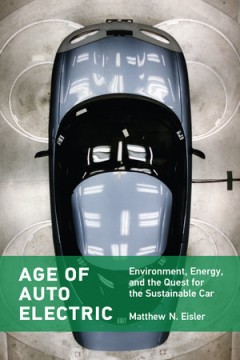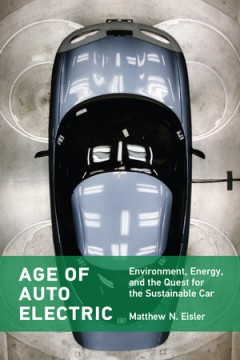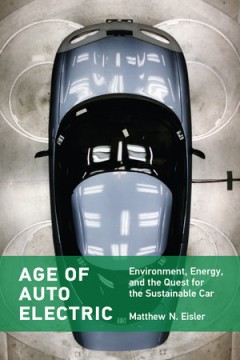Filter by

Age of Auto Electric: Environment, Energy, and the Quest for the Sustainable Car
The electric vehicle revival reflects negotiations between public policy, which promotes clean, fuel-efficient vehicles, and the auto industry, which promotes high-performance vehicles. Electric cars were once as numerous as internal combustion engine cars before all but vanishing from American roads around World War I. Now, we are in the midst of an electric vehicle revival, and the goal fo…
- Edition
- Ed. 1
- ISBN/ISSN
- 9780262372022
- Collation
- 378
- Series Title
- -
- Call Number
- 621.31 EIS a

Age of auto electric :environment, energy, and the quest for the sustainable …
"In Age of Auto Electric, Eisler argues that electric vehicle revival was driven not by better batteries but by the interplay between changing environmental and socio-economic conditions, energy and environmental policies, systems of energy conversion and industrial production, and material practices of innovation"--OCLC-licensed vendor bibliographic record.
- Edition
- -
- ISBN/ISSN
- 9780262544573
- Collation
- 1 online resource
- Series Title
- -
- Call Number
- -

Age of Auto Electric: Environment, Energy, and the Quest for the Sustainable Car
The electric vehicle revival reflects negotiations between public policy, which promotes clean, fuel-efficient vehicles, and the auto industry, which promotes high-performance vehicles. Electric cars were once as numerous as internal combustion engine cars before all but vanishing from American roads around World War I. Now, we are in the midst of an electric vehicle revival, and the goal fo…
- Edition
- Ed. 1
- ISBN/ISSN
- 9780262372022
- Collation
- -
- Series Title
- -
- Call Number
- 500 EIS a

Age of Auto Electric: Environment, Energy, and the Quest for the Sustainable Car
Electric cars were once as numerous as internal combustion engine cars before all but vanishing from American roads around World War I. Now, we are in the midst of an electric vehicle revival, and the goal for a sustainable car seems to be within reach. In Age of Auto Electric, Matthew N. Eisler shows that the halting development of the electric car in the intervening decades was a consequence …
- Edition
- -
- ISBN/ISSN
- 9780262372022
- Collation
- -
- Series Title
- -
- Call Number
- -

Age of Auto Electric: Environment, Energy, and the Quest for the Sustainable Car
The electric vehicle revival reflects negotiations between public policy, which promotes clean, fuel-efficient vehicles, and the auto industry, which promotes high-performance vehicles. Electric cars were once as numerous as internal combustion engine cars before all but vanishing from American roads around World War I. Now, we are in the midst of an electric vehicle revival, and the goal fo…
- Edition
- -
- ISBN/ISSN
- 9780262372022
- Collation
- -
- Series Title
- -
- Call Number
- 629.222
 Computer Science, Information & General Works
Computer Science, Information & General Works  Philosophy & Psychology
Philosophy & Psychology  Religion
Religion  Social Sciences
Social Sciences  Language
Language  Pure Science
Pure Science  Applied Sciences
Applied Sciences  Art & Recreation
Art & Recreation  Literature
Literature  History & Geography
History & Geography